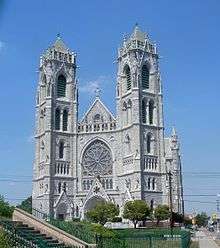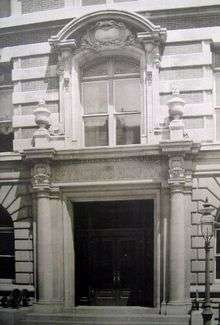Schickel & Ditmars
Schickel & Ditmars was an architectural firm in New York City, active during the city's Gilded Age from 1885 until the early 1900s. It was responsible for many fine churches, residences, and business buildings. J. William Schickel (1850–1907) formed the firm in 1885 as William Schickel & Company, in association with Isaac E. Ditmars (1850–1934) and Hugo Kafka (1843–1913). The firm's name changed to Schickel and Ditmars in 1895, and continued under the direction of Ditmars after Schickel's death in 1907. The firm "enjoyed considerable patronage from German-American clients" and produced a large number of works for the Roman Catholic Archdiocese of New York.[1] The firm "focused primarily, although not exclusively, on preparing designs for Roman Catholic churches and institutional buildings," particularly Roman Catholic churches for German-American parishes.[2] The firm's address was listed at 111 Fifth Avenue, New York City.
Schickel & Ditmars were the architects responsible for much of Lenox Hill Hospital (under its previous name, "The German Hospital") as it grew into its present location on the Upper East Side.
The prominent architect and artist Harold Van Buren Magonigle was counted amongst the firm's employees.[3]
Noteworthy structures
Churches and Ecclesiastical Projects:
- St. Boniface Roman Catholic Church and rectory, Rochester, New York (1887) Demolished due to fire. Rectory extant.
- St. Liborius Roman Catholic Church, St. Louis, Missouri (1889) Demolished [4]
- St. Louis Roman Catholic Church, 780-790 Main Street, Buffalo, New York (1889) [5]
- St. Joseph's Roman Catholic Church, 408 East 87th Street, Yorkville, New York City (1895) [6]
- St. Joseph's Seminary, Dunwoodie (1896), 201 Seminary Avenue, Yonkers, New York[2]
- The Church of the Ascension (RC) (1896–1897), 221 West 107th Street, Upper West Side, Manhattan, New York City
- St. Ignatius of Loyola, (1898)
- Evangelical Lutheran Church of the Holy Trinity (1902), Central Park West, NW corner of 65th Street, a church with rectory built for $125,000.[7]

- George Ehret Mausoleum, Woodlawn Cemetery, Bronx, New York City, New York,(1900)
- Basilica of the Sacred Heart of Jesus in Newark, New Jersey, "following the dismissal of its original architect Jeremiah O'Rourke in 1910."[2]

Hospitals and Institutions:
- St. Peter's Hospital, 274 Henry Street, Brooklyn, (1888-9)
- The Catholic Club of New York, 120 Central Park South, New York City, New York (1892, demolished mid-20th century)
- The German Hospital, New York City, New York (1900, demolished), SW corner of 77th Street and Lexington Avenue, a five-story and basement brick hospital, built for the German Hospital for $120,000.[7]
- 523-531 E 86th Street, (1907), a 5-6-story brick stone dwelling with chapel, built for $125,000 for the Sisters of Misericorde.
- St. Ignatius' School, 46-50 E 84th Street, (1907), built for the Church of St. Ignatius for $150,000.[7]
- St. Lawrence Hospital, 430-432 West 164th Street, New York City, New York, (1912–13)
- The German Hospital Nursing School, 1084-1090 Lexington Avenue, New York City, New York (1916), a nine-story brick nursing school, built for the German Hospital two years before it would be renamed to Lenox Hill.[7]
- The St. Vincent de Paul Hospital School of Nursing, 1-17 Seventh Avenue and 148-172 West 12th Street, New York City, New York (1924, Seventh Avenue structures demolished for 1951 Al Smith building)
Commercial, Office and Industrial Buildings:
- The Constable Building Annex, 12 East 18th Street, New York City, New York (1886-7)
- The Mercer Hotel 99 Prince Street, New York City, New York, (1887-8)
- Ehrich Brothers Emporium, 695-709 Sixth Avenue, New York City, New York (1889)
- The Constable Building Office Tower, 109-111th Fifth Avenue, New York City, New York (1894-5)
- The Conley Foil Company Building, 521-537 West 25th Street, New York City, New York (1900), a four-story and basement brick factory, built for Conley Foil Co. for $165,000.[7]
- The Johntson Building, 1166-1172 (1170) Broadway, New York City, New York (1902-3), a 12-story stone front office building with stores, built for Caroline H Johnston, Stuttgart, Germany, attorney, and Frederick A Constable of 9 E 83rd St for $500,000.[5][7]
- 38 West 21st Street, New York City, New York (1908) [5]
Residences:
- The Leonard and Annie Weiderer House, 387 St. Paul's Avenue, Staten Island, New York, (1886–1888)[8]
- The John D. Crimmins, Esq., Residence, 40-42 East 68th Street, New York City, New York, (1898) addition, renovation and new facade[6]
- The Mrs. Thomas F. Ryan Residence, 1 West 12th Street, (1901, demolished)[6]
- The Isaac Stern Residence, 858 5th Ave., New York City, New York (1900) [6]
- The Louis Stern Residence, 993 5th Ave., New York City, New York (1900)
- The Isaac Stern Residence, 42 East 52nd Street, New York City, New York (1904) [6]
See also
The firm's founding associates: William Shickel (1850–1907), Isaac Ditmars (1850–1934), and Hugo Kafka (1843–1913).
References
- ↑ Decker, Kevin F. "J. William Schickel (1850-1907)", University of Plattsburgh, New York (2000)
- 1 2 3 Decker, Kevin F. "Isaac E. Ditmars (1850-1934)", University of Plattsburgh, New York (2000)
- ↑ "Pencil points reader: a journal for the drafting room, 1920-1943" Hartman, G.E. and Cigliano, J. Princeton Architectural Press.(2004)
- ↑ at nyc-architecture.com
- 1 2 3 Schickel and Ditmars at emporis.com
- 1 2 3 4 5 6 Schickel & Ditmars at the archINFORM database.
- 1 2 3 4 5 6 Office for Metropolitan History, "Manhattan NB Database 1900-1986", 5 Feb 2010.
- ↑ Travels of St. Paul's Avenue, Staten Island at forgotten-ny.com
- Dunlap, David W. From Abyssinian to Zion: A Guide to Manhattan's Houses of Worship. New York: Columbia University Press, 2004.
- St. Ignatius Loyola, A Pictorial History and Walking Guide of New York City’s Church of St. Ignatius Loyola, 1999; Photos by Laurie Lambrecht